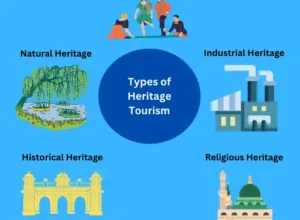
What is Art Tourism and Its Importance?
Travelling and experiencing art and culture is known as art tourism or cultural tourism. Art tourists seek to immerse themselves in a destination’s artistic and cultural offerings, encompassing visual arts, music, and architecture. This article highlights the significance of art tourism and how it promotes historical preservation, economic growth, and cross-cultural exchange. Additionally, it discusses how to increase the sustainability of tourism by encouraging eco-friendly travel, educating tourists, and involving the local population. Art tourism is a meaningful form of travel in a society that values cultural knowledge and supporting local artists.
Art Tourism
Art tourism, also known as cultural tourism or arts tourism, is a form of tourism that focuses on experiencing and appreciating various forms of art and culture. Travelers who engage in art tourism are motivated by a desire to explore and immerse themselves in the artistic and cultural heritage of a destination. This type of tourism encompasses a wide range of artistic expressions, including visual arts, performing arts, music, architecture, and more.
Importance of Art Tourism?
For a number of reasons, art tourism is very important. It helps tourists who are looking to broaden their cultural horizons as well as destinations, local communities, and the arts and culture industry. Here are some main justifications for the significance of art tourism.
- Culture Exchange
- Economic Benefits
- Preservation of Heritage
- Awareness and Education
- Community Engagement
- Enhancement of Quality Life
- Sustainable Development
- Global Art Exchange
- Promotion of Understanding and Tolerance
- Promotion of Local Artisans and Artists
Culture Exchange
Art tourism facilitates cultural exchange by allowing travelers to immerse themselves in the art, traditions, and heritage of a destination. Global cultural awareness and harmony are promoted by this interchange, which also deepens understanding and appreciation of other cultures.
Economic Benefits
Local communities and travel destinations benefit economically from art tourism. Positions in the hospitality, restaurant, retail and transportation sectors are supported, as are positions in the arts and culture sector. The money generated by art tourism helps a region’s economy flourish.
Preservation of Heritage
The preservation and up keep of historical and cultural landmarks, artworks, and customs can be financially supported by art tourism. The restoration and preservation of significant cultural assets are frequently supported by entrance fees and tourism-related income.
Awareness and Education
Learning about history, culture, and artistic techniques is encouraged through the educational experience of art tourism. The creative diversity of the world, historical histories, and current challenges are all better understood by visitors.
Community Engagement
Engaging with local communities through cultural events, craft workshops, and cultural exchanges is a common aspect of art tourism. In addition to fostering a sense of community among locals, this engagement lets visitors bond with the locals.
Enhancement of Quality Life
Living in an area with a thriving arts and cultural sector can improve the standard of living for locals. The community can benefit from cultural activities and artistic expression, which can also instill a sense of pride in the area’s history.
Sustainable Development
When properly handled, art tourism makes a positive impact on social well-being, the environment, and local customs. Long-term advantages for visitors and destinations can be ensured through the use of sustainable practices in art tourism.
Global Art Exchange
Cross-border exchange of ideas and creative developments can be facilitated by art tourism. It can promote cooperation between artists from various geographic areas, resulting in the production of fresh and varied artistic works.
Promotion of Understanding and Tolerance
Tolerance, variety, and international understanding can be fostered via exposure to other artistic mediums and cultural practices. Stereotypes and false beliefs about other cultures and societies can be dispelled with its assistance.
Promotion of Local Artisans and Artists
By giving them a market for their goods, art tourism supports and encourages regional craftspeople, artists, and artisans. This promotes modern artistic expressions in addition to maintaining classic art forms.
How to Properly Apply Initiatives for Sustainable Tourism?
A holistic strategy that strikes a balance between social, economic, and environmental objectives is necessary for the successful implementation of sustainable tourism policies. The following are essential actions to properly apply such strategies.
Planning and Assessment
- Examine the environmental, social, and economic conditions of your location in detail. Decide on the main obstacles and chances.
- Formulate a long-term plan for sustainable tourism, incorporating enterprises, non-governmental organizations, government agencies, and local communities.
Community Involvement
Participate in tourism-related activities to empower local communities. Encourage the establishment of jobs, local business, and cultural preservation in the neighborhood.
Marketing and Promotion
Create marketing campaigns that highlight ethical travel and sustainability practices. Emphasize the distinctive natural and cultural features of your travel destination.
Certification and Standards
Motivate travel companies to get sustainability certifications from organizations like Green Globe, Earth Check, or other relevant ones for your area. These accreditations can be used by companies and travelers to find environmentally friendly solutions.
Evaluation and Monitoring
Create a mechanism to track and assess the effects of tourism on the economy, the environment, and local communities on a regular basis. Make any necessary changes to your strategy using this data.
Adaptation and Flexibility
Be prepared to modify your plans in response to evolving conditions, market trends, and stakeholder input. Being flexible is necessary for the continuous process of sustainable tourism.
Destination Branding
Create a compelling and distinctive destination brand that demonstrates your dedication to sustainable travel and ethical tourism.
Reporting and Transparency
Continue to be transparent in your efforts by providing regular updates on your advancements and successes in the field of sustainable tourism.
Rewards for Eco-Friendly Transportation
Encourage eco-friendly modes of transportation like biking, public transportation, and electric cars, and provide rewards for utilizing them.
Enhance Travel During Off-Season
Motivate travelers to come during the off-peak season to ease the burden on infrastructure and resources during the busy season.
Being Crisis Ready
Make plans for handling unforeseen circumstances that could affect the sustainability of your tourism industry, such as disease outbreaks or natural disasters.
Education of Visitors
Make travelers more conscious of the value of sustainable and ethical travel. Give details about regional traditions, environmental initiatives, and eco-friendly activities.
Conclusion
Art tourism is a significant driver of cultural exchange, economic growth, and heritage preservation, while also fostering community engagement and sustainable development. It promotes global art exchange, understanding, and support for local artisans. To ensure success, sustainable tourism initiatives should focus on planning, community involvement, marketing, certification, evaluation, and flexibility, with an emphasis on eco-friendly transportation, off-season travel, crisis preparedness, and visitor education.
You may like:
Top 12 Philippine Tourist Spots




